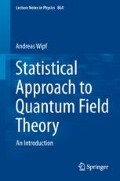Abstract
In this introductory chapter of the book we briefly summarize the historical development of quantum field theory and lattice theories. Beginning with the Dreimännerarbeit back in 1925 we sketch the development of gauge theories and their role in elementary particle physics. Finally we comment on the fruitful interrelation between quantum field theory and classical statistical physics.
Access this chapter
Tax calculation will be finalised at checkout
Purchases are for personal use only
References
M. Born, P. Jordan, Zur Quantenmechanik. Z. Phys. 34, 858 (1925)
M. Born, W. Heisenberg, P. Jordan, Zur Quantenmechanik II. Z. Phys. 35, 557 (1926)
P.A.M. Dirac, The quantum theory of emission and absorption of radiation. Proc. R. Soc. Lond. A 114, 243 (1927)
P. Jordan, W. Pauli, Zur Quantenelektrodynamik. Z. Phys. 47, 151 (1928)
W. Heisenberg, W. Pauli, Zur Quantendynamik der Wellenfelder I. Z. Phys. 56, 1 (1929)
W. Heisenberg, W. Pauli, Zur Quantendynamik der Wellenfelder II. Z. Phys. 59, 168 (1930)
F.J. Dyson, The S-matrix in quantum electrodynamics. Phys. Rev. 75, 1736 (1949)
J. Schwinger, On the Euclidean structure of relativistic field theory. Proc. Natl. Acad. Sci. USA 44, 956 (1958)
K. Symanzik, Euclidean quantum field theory, I. Equations for a scalar model. J. Math. Phys. 7, 510 (1966)
C.N. Yang, R.L. Mills, Conservation of isotopic spin and isotopic gauge invariance. Phys. Rev. 96, 191 (1954)
S.L. Glashow, Partial-symmetries of weak interaction. Nucl. Phys. 22, 579 (1961)
S. Weinberg, A model of leptons. Phys. Rev. Lett. 19, 1264 (1964)
A. Salam, Weak and electromagnetic interactions, in Elementary Particle Theory (Almquist and Wiksell, Stockholm, 1968)
G. ’t Hooft, Renormalizable Lagrangians for massive Yang–Mills fields. Nucl. Phys. B 35, 167 (1971)
H. Fritzsch, M. Gell-Mann, H. Leutwyler, Advantages of the color octet cluon picture. Phys. Lett. B 47, 365 (1973)
R. Feynman, Spacetime approach to non-relativistic quantum mechanic. Rev. Mod. Phys. 20, 267 (1948)
F.J. Wegner, Duality in generalized Ising models and phase transitions without local order parameters. J. Math. Phys. 10, 2259 (1971)
K.G. Wilson, Confinement of quarks. Phys. Rev. D 10, 2445 (1974)
M. Creutz, Confinement and the critical dimensionality of spacetime. Phys. Rev. Lett. 43, 553 (1979)
M. Creutz, Monte Carlo simulations in lattice gauge theories. Phys. Rep. 95, 201 (1983)
Author information
Authors and Affiliations
Rights and permissions
Copyright information
© 2013 Springer-Verlag Berlin Heidelberg
About this chapter
Cite this chapter
Wipf, A. (2013). Introduction. In: Statistical Approach to Quantum Field Theory. Lecture Notes in Physics, vol 100. Springer, Berlin, Heidelberg. https://doi.org/10.1007/978-3-642-33105-3_1
Download citation
DOI: https://doi.org/10.1007/978-3-642-33105-3_1
Publisher Name: Springer, Berlin, Heidelberg
Print ISBN: 978-3-642-33104-6
Online ISBN: 978-3-642-33105-3
eBook Packages: Physics and AstronomyPhysics and Astronomy (R0)

